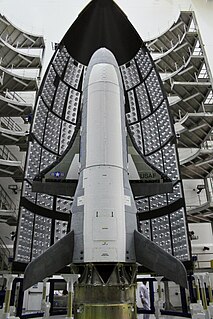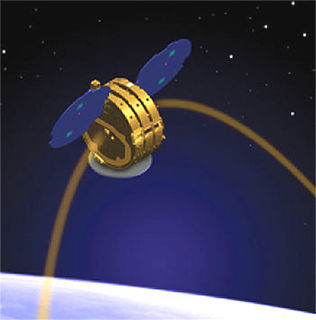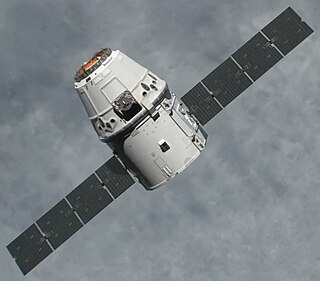Related Research Articles

The Boeing X-37, also known as the Orbital Test Vehicle (OTV), is a reusable robotic spacecraft. It is boosted into space by a launch vehicle, then re-enters Earth's atmosphere and lands as a spaceplane. The X-37 is operated by the United States Space Force, and was previously operated by Air Force Space Command until 2019 for orbital spaceflight missions intended to demonstrate reusable space technologies. It is a 120-percent-scaled derivative of the earlier Boeing X-40. The X-37 began as a NASA project in 1999, before being transferred to the United States Department of Defense in 2004.

TacSat-1 was an experimental satellite built by the Naval Research Laboratory on behalf of the United States Department of Defense (DOD) Office of Force Transformation (OFT). It was the planned payload of the sixth launch of the SpaceX Falcon 1. It was however never launched into space. The second satellite in the series, TacSat-2, launched before TacSat-1 and this led to the cancellation of TacSat-1's launch.

This is the comparison of orbital launch systems page. It contains two lists of conventional orbital launch systems, separated by operational status. For the simple list of all conventional launcher families, see: Comparison of orbital launchers families. For the list of predominantly solid-fueled orbital launch systems, see: Comparison of solid-fueled orbital launch systems.
The Long March 3B, also known as the CZ-3B and LM-3B, is a Chinese orbital launch vehicle. Introduced in 1996, it is launched from Launch Area 2 and 3 at the Xichang Satellite Launch Center in Sichuan. A three-stage rocket with four strap-on liquid rocket boosters, it is currently the second most powerful member of the Long March rocket family after the Long March 5 and the heaviest of the Long March 3 rocket family, and is mainly used to place communications satellites into geosynchronous orbits.
ChinaSat 9, also known as ZX-9, is a Chinese communications satellite. It was launched from pad 2 at the Xichang Satellite Launch Centre on 9 June 2008, at 12:15 GMT, by a Long March 3B carrier rocket. It is based on the Spacebus 4000C2 satellite bus, and was constructed in France by Thales Alenia Space in its Cannes Mandelieu Space Center. It is one of several ChinaSat spacecraft in orbit.
Orbcomm is a family of low Earth orbit communications satellites, operated by the American satellite communications company Orbcomm. As of July 2014, 51 such satellites have orbited Earth, with 50 still continuing to do so.

The year 2012 saw a number of significant events in spaceflight. In May and October, the first Commercial Orbital Transportation Services resupply missions took place, during which the SpaceX Dragon became the first private spacecraft to dock with the International Space Station (ISS). In June, China launched the crewed Shenzhou 9 orbital mission, and North Korea achieved its first successful orbital launch in December. 2012 also saw China's first successful asteroid exploration mission, and the landing of NASA's Curiosity rover on Mars. The Vega and Unha-3 rockets made their maiden flights in 2012, while the Proton-K made its last.

A heavy-lift launch vehicle, HLV or HLLV, is an orbital launch vehicle capable of lifting between 20,000 to 50,000 kg into low Earth orbit (LEO). As of 2019, operational heavy-lift launch vehicles include the Ariane 5, the Long March 5, the Proton-M and the Delta IV Heavy. In addition, the Angara A5, the Falcon 9 Full Thrust, and the Falcon Heavy are designed to provide heavy-lift capabilities in at least some configurations but have not yet been proven to carry a 20-tonne payload into LEO. Several other heavy-lift rockets are in development. An HLV is between medium-lift launch vehicles and super heavy-lift launch vehicles.

Several new rockets and spaceports began operations in 2016.

This article documents notable spaceflight events during the year 2019.

This article lists achieved spaceflight events in 2018. For the first time since 1990, more than 100 orbital launches were performed globally.
VesselSat-1 was a miniaturized satellite built and owned by LuxSpace, which was operated by Orbcomm under lease. VesselSat-1 and its sister satellite, VesselSat-2 were used by Orbcomm to compensate the functionality of the malfunctioning Orbcomm-QL satellites.
LuxSpace is a European space systems contractor based in Betzdorf in Luxembourg. It was founded in November 2004 as a daughter company of OHB AG, and began operations as a joint venture with SES Astra in January 2005.
Ziyuan 3-01 or ZY 3-01 is a Chinese Earth observation satellite launched in January 2012. It is a high-resolution imaging satellite operated by the Ministry of Land and Resources of the People's Republic of China.
Technology Education Satellite (TechEdSat) is a class of CubeSats built by San Jose State University and University of Idaho students in partnership with NASA's Ames Research Center. These satellites have tested communication technology for smallsats, and have contributed to the development of the Small Payload Quick Return (SPQR) concept.
This page includes a list of satellite buses, of which multiple similar artificial satellites have been, or are being, built to the same model of structural frame, propulsion, spacecraft power and intra-spacecraft communication. Only commercially available buses are included, thus excluding series-produced proprietary satellites operated only by their makers.

ÑuSat satellite series, is a series of Argentinean commercial Earth observation satellites. They form the Aleph-1 constellation, which is designed, built and operated by Satellogic.

This article documents notable spaceflight events during the year 2020.
A satellite dispenser is a space tug usually released from the upper stage of a rocket and designed to fly small secondary payloads to their desired location before deploying them.
References
- 1 2 Krebs, Gunter. "VesselSat 1, 2, 3". Gunter's Space Page. Retrieved 15 October 2019.
- ↑ "VESSELSAT 2 Satellite details 2012-001B NORAD 38047". N2YO. 31 October 2013. Retrieved 31 October 2013.
- ↑ 中国成功发射首颗高精度立体测绘卫星"资源三号" (in Chinese). ChinaNews.com. 9 January 2012. Retrieved 9 January 2012.
- ↑ Barbosa, Rui C. (8 January 2012). "China opens 2012 with ZiYuan-3 launch via Long March 4B". NASASpaceflight.com. Retrieved 9 January 2012.